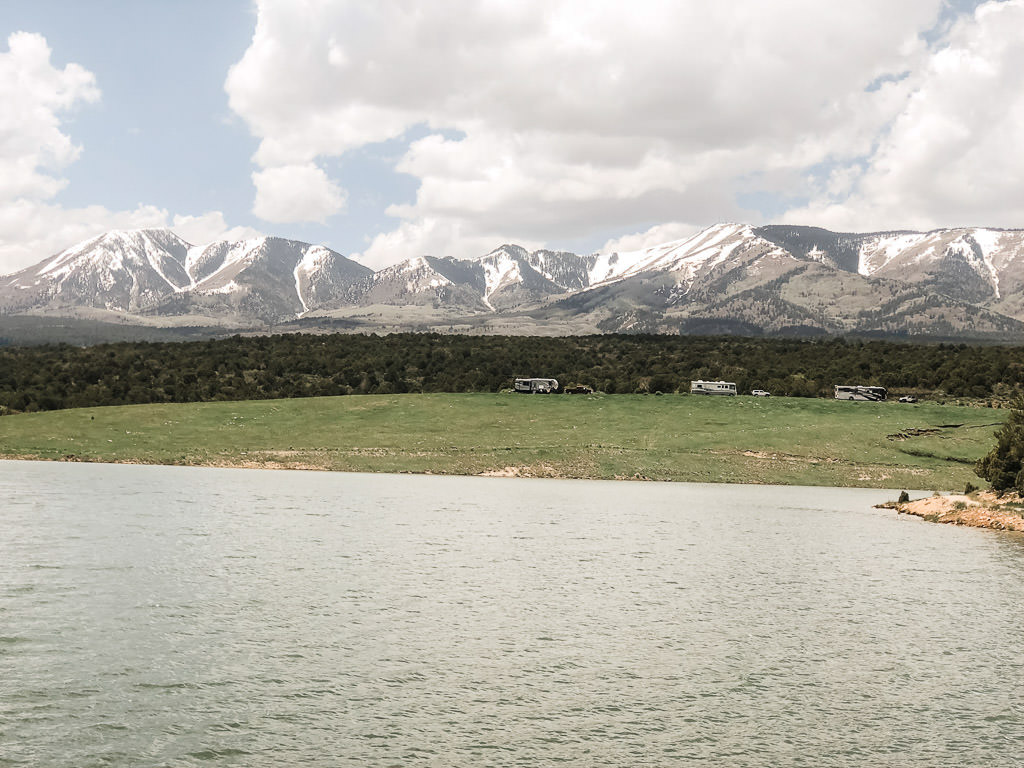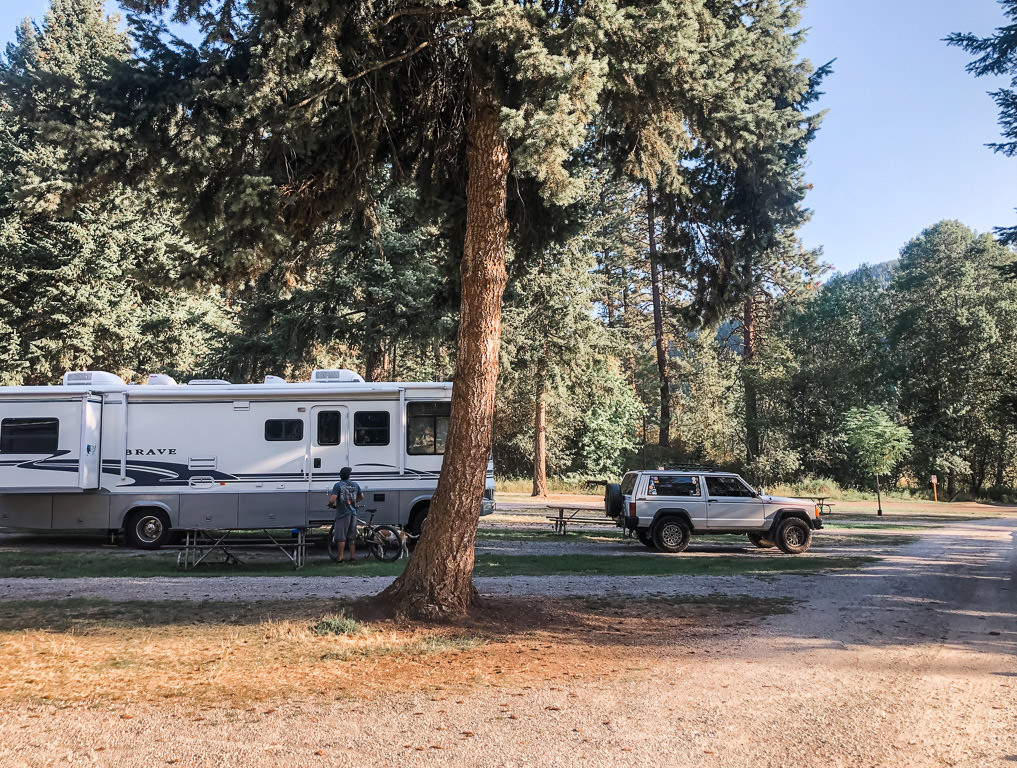
What to Look for in a Campground
What to Look for in a Campground
Tips for how to pick the best RV site during your travels.
By: Jessie & Ashley Segura
We've learned quite a few things the hard way in our first six months of traveling. One of which is knowing what makes a campground great and what makes a campground not-so-great.
Camping can be a dream, just park your Winnebago and prop your feet up as you look out onto the beautiful outdoors. But, with the growing popularity of full-time RVing, these days some campgrounds just can't keep up.
Here are a few of the biggest things we look into when deciding between Campground A or Campground B.

Does the Campground Offer Full, Partial, or No Hook-Ups Sites?
Having a full hook-up campground site is the difference between a hot shower while you have the heater running compared to a quick, cold body shower followed by the fastest towel dry of your life in order to get warm clothes on ASAP.
Not every campground offers full hook-up sites: electricity, water, and sewer access on your individual site. However, most of the time, you can find a campground that offers "partial hook-ups." This usually means you get 30 amps of power, instead of the normal 50 amps, and a water hook-up.
Considerations of not having full-hookups
Thirty amps of power is sufficient, but we've learned that it can limit us in terms of how many things we have on at once. We have dual AC units in our Winnebago Brave (thank the good Lord!!) and 30 amps can support running them both. But the moment we turn the microwave on, too, oh boy! Get ready for a power outage, folks.
To help avoid these moments, always check the power board inside your coach (where your tank status and water pump button is located) to see how much power you're using.
Especially keep an eye on your power usage when you're running multiple things at once. Those digits will climb to 30 before you know it and the moment it goes past 30 ... BOOM ... power outage. It's a good idea to have a surge protector in place as well, so that you can convert either 30 or 50 amp power to your coach. We've heard a few horror stories from those who thought they could get away without a surge protector, so better safe than sorry.
Another thing to keep in mind with partial hook-up sites is that they usually don't have a sewer hook-up. Most campgrounds that offer partial hook-ups will have a free dump on-site, but that means packing up, bringing in the slides, and driving down every time those black and grey tanks get full. You can also purchase one of those lovely portable tanks to lug your tank excess to the dump in if that's your jam. Note: Always check campground policy around portable tanks or other rules around emptying tanks.
In terms of pricing and availability, it's always way easier to find partial hook-up sites, especially if you're a last-minute route planner. Financially there isn't usually a huge difference, generally just a $5-$10 increase from partial to full hook-ups.
No hook-ups is exactly how it reads: nada. You don't get water, electricity, or sewer, so you might as well be boondocking (camping for free on public lands) unless the campground offers that perfect location right on the water. However, some do still have dump stations and water fill-ups.
Location, Location, Location
Whenever we score an amazing campground site, Jessie and I turn to each other and say, "Location, location, location." Where you are located really is everything, especially in a campground site.

After staying at dozens of campgrounds now, we have a list of what we look for in a great site:
- Full hook-ups or at least partial.
- Lots of trees or bushes on either side for privacy between neighbors.
- Only one side of neighbors, if possible.
- Views available through our living room and front driver windows.
- Far enough away from all of the public amenities, but close enough for when we decide to use them.
Sure, you can call us picky, but at least we know what we like! And plus, we don't always luck out when it comes to picking a great site location. Sometimes we may think it's met each of those bullet points and then discover a day or two later how wrong we were. Other times we have to take that last and only site that's left, the one right smack in the middle of all the action with no privacy on either side and neighbors' slide-outs almost kissing ours.
To help avoid those not-so-lovely sites, I call the campground ahead of time and ask the host what their favorite sites are, which ones are the most private and/or close to the "lake, ocean, stream, river, mountain view, etc." Campground hosts know the good spots and as long as those sites aren't taken for your stay, they are happy to share the top sites with you.
If you can't get a hold of the campground host, head on over to TripAdvisor or Campendium and start reading campground reviews. When people find a site they love, they tend to spoil the secret site number in their campground review.
Look at photos of the campground sites and scan reviews to discover which site number is most likely to satisfy each of your bullets.
Will Our Winnebago Fit in the Campground Site?
This may seem like an obvious point, but trust us, it's not. Almost every campground has pretty clear restrictions as to what size coach can fit into each site, but every once in a while you'll come across an unknown site length and attempt to "see" if your Winnie fits. This makes for a whole lot of backing up, pulling in, starting over, and trying again at a different angle only to discover ... you don't fit.
After getting tired of yelling through the windows to back up or pull forward more, we finally invested in walkie talkies to make it easier to park our 34' Brave. We quickly discovered this made communicating a whole lot easier when pulling into a new site (and quieter).
Plan ahead to make sure the campground itself can accommodate your rig driving through it, as well. Many campgrounds in and around National Parks can only accommodate 30' and smaller coaches. That means you can't even drive your coach through it if you're over that. Trying to locate our first campground late in the night in Bryce Canyon, we learned that little lesson the hard way... but that's a story for another day.
For more helpful tips for setting up your campsite, check out this article by a fellow GoLifer.
Is the Campground Affordable? Do They Offer Memberships or Discounts?
If you haven't already, we recommend signing up for a Good Sam membership and AAA discount card. These two go hand-in-hand when it comes to getting a discount on your nightly campground stay.
Bouncing from site to site every 4-5 days can add up quickly, even with a discount card. That's why for the second half of our year-long journey we will be committing to a campground for at least a month. When you do monthly or annual stays, some campgrounds will usually offer a significant discount.
You can also join campground memberships like Thousand Trails and get access to a ton of stays for just one annual fee. We discovered Thousand Trails in our 4th month of travels, so we ended up re-routing our 5th and 6th months around those locations to help cut costs.
However, memberships like these will have fine print details you'll need to pay attention to. For example, Thousand Trails allows you to stay 14-days consecutively in one site, but then you can't camp in one of their campgrounds for seven nights after. There are a few more small details with their policy, but as long as you understand and know the rules, it's an affordable way to travel with your Winnebago.

What Are the Reviews Telling You?
It's a rare occasion that we stay in a campground that I haven't thoroughly researched and read every single review. Like restaurants, campground reviews can be extremely telling of what to expect. If the campground site says they're 10 minutes to the national park and the reviews complain that they're really 30 minutes away because of the local traffic nearby, you might consider a different campground. Also, if you have kids, check out this list of additional considerations to keep in mind for family-friendly camping - like site size and amenities.
Sure, some people are a bit more opinionated than others, but reviews can tell you so much more about a campground than the website.
When scanning for reviews, I look for the following:
- Any tips on which sites are the best?
- How updated the amenities are; if they have any?
- Do the laundry facilities work?
- How accurate is the location?
- Are there many permanent resident sites?
- Is there a lottery dump system?
- Are the sites maintained?
- What is the shade coverage like?
I know, I know, it's a lot of bullets again, but some folks will literally tell-all in their campground reviews. It can be extremely helpful to have a deal-breaker when you're torn between two different campgrounds and can't make up your mind. Head on over to the reviews and they'll usually help make that decision for you.
When you're scouting your next campground what do you look for? Comment below with your campground scouting tips!
Comments
Comments on this post are moderated, so they will not appear instantly. All relevant questions and helpful notes are welcome! If you have a service inquiry or question related to your RV, please reach out to the customer care team directly using the phone numbers or contact form on this page .